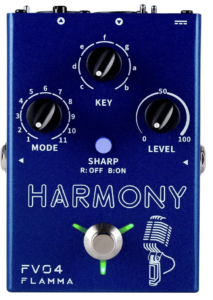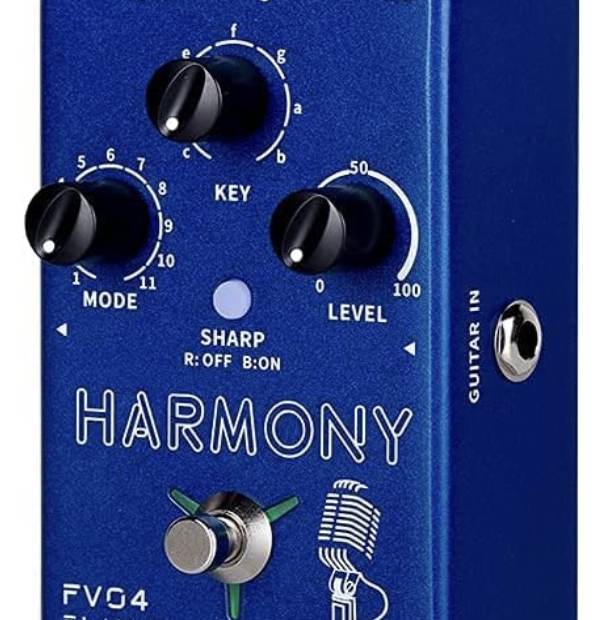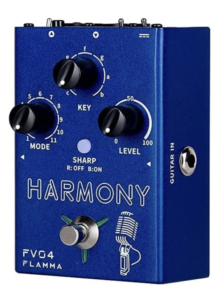The FLAMMA FV04 Harmony is a vocal effects processor pedal designed to enhance the sound of both vocalists and guitarists. It offers a range of features and effects aimed at improving the overall performance and sound quality.
Here are some key details about the FLAMMA FV04 Harmony vocal processor:
Harmony Modes
 The FLAMMA FV04 Harmony [buy here] offers a variety of harmony modes that allow you to add harmonies to your vocal performance. Harmonies are additional notes that accompany the main vocal line, creating a richer and more complex sound. These harmony modes are designed to enhance your vocal performance and add depth to your sound. Here’s a breakdown of the different harmony modes offered by the FV04 Harmony:
The FLAMMA FV04 Harmony [buy here] offers a variety of harmony modes that allow you to add harmonies to your vocal performance. Harmonies are additional notes that accompany the main vocal line, creating a richer and more complex sound. These harmony modes are designed to enhance your vocal performance and add depth to your sound. Here’s a breakdown of the different harmony modes offered by the FV04 Harmony:
- OCT- (Octave Down): This mode generates a harmony note that is one octave lower than the main vocal line. It adds depth and richness to your vocals, creating a full and resonant sound.
- OCT+ (Octave Up): In this mode, the harmony note is one octave higher than the main vocal line. It can create a bright and airy quality to your vocals.
- 3th L (Third Lower): This mode generates a harmony note that is a third lower than the main vocal. It can add a sense of depth and complexity to your singing.
- 3th H (Third Higher): This mode generates a harmony note that is a third higher than the main vocal. It can add a touch of brightness and complexity to your vocal performance.
- 5th L (Fifth Lower): In this mode, the harmony note is a fifth lower than the main vocal. It adds a harmonically rich quality to your vocals.
- 5th H (Fifth Higher): This mode generates a harmony note that is a fifth higher than the main vocal. It can add brightness and complexity to your vocal sound.
- OCT- & OCT+ (Octave Down and Octave Up): This mode combines both the octave-down and octave-up harmonies for a unique and layered effect.
- 3rdL&3rd H (Third Lower and Third Higher): This mode combines both the third-lower and third-higher harmonies, adding depth and complexity to your singing.
- 5th L&3rd H (Fifth Lower and Third Higher): In this mode, a lower fifth harmony is combined with a higher third harmony, creating an interesting and harmonically rich vocal effect.
- 3rd H&5th H (Third Higher and Fifth Higher): This mode combines a higher third harmony with a higher fifth harmony, adding brightness and complexity to your vocals.
- 5th L&5th H (Fifth Lower and Fifth Higher): This mode combines a lower fifth harmony with a higher fifth harmony, creating a harmonically rich and layered vocal sound.
These harmony modes offer a wide range of options for adding harmonies to your vocals, allowing you to create unique and captivating performances. You can select the harmony mode that best complements your main vocal line and enhances the overall musical arrangement.
Zoom V6 Vocal Processor Review
TC Helicon X1 Vocal Effects Processor: Review
Roland VT-4 Vocal Transformer Review
Zoom V3 Vocal Processor Review
Boss VE-500 Vocal Performer Review
9 Best Vocal Effects Pedals for 2023
Microphone Amplifier
The Flamma V04 Harmony [buy here] can be used as a microphone amplifier, offering versatility in different performance scenarios.
The FLAMMA FV04 Harmony, in addition to its vocal and guitar effects capabilities, can also function as a microphone amplifier. This means that you can use the FV04 to amplify the signal from a microphone, making it louder and suitable for various performance or recording scenarios. Here’s how the FV04 can serve as a microphone amplifier:
- Microphone Input: The FV04 has a dedicated microphone input in the form of an XLR balanced input jack. This input is designed to accommodate microphones commonly used in live performances and recording setups.
- Microphone Gain Control: The pedal features a GAIN knob that allows you to adjust the gain level of the microphone input. Gain control is essential for setting the appropriate input sensitivity and achieving the desired level of amplification.
- Phantom Power: The FV04 supports 48V phantom power, which is often required for certain types of microphones, particularly condenser microphones. Phantom power provides the necessary voltage to power the microphone’s internal electronics.
- Microphone Amplification: When you connect a microphone to the FV04’s XLR input and adjust the gain control, the pedal will amplify the microphone’s signal. This amplified signal can then be sent to the pedal’s output jacks for further processing or direct connection to a sound system, mixer, or recording device.
- Effects and Reverb: While using the FV04 as a microphone amplifier, you can also take advantage of the pedal’s dedicated reverb effects designed for vocals. Applying reverb to the microphone signal can add depth and ambience to your vocals, enhancing the overall sound quality.
- Output Options: The FV04 offers two different output modes for mixed signal or individual signal from both guitar and microphone. Depending on your setup, you can choose the output configuration that suits your needs.
 Using the FV04 as a microphone amplifier can be particularly useful in scenarios where you need to amplify your voice, such as live performances, rehearsals, home recording sessions, and more. The pedal’s microphone amplifier functionality, combined with its effects processing capabilities, provides a versatile solution for vocalists and performers.
Using the FV04 as a microphone amplifier can be particularly useful in scenarios where you need to amplify your voice, such as live performances, rehearsals, home recording sessions, and more. The pedal’s microphone amplifier functionality, combined with its effects processing capabilities, provides a versatile solution for vocalists and performers.
Pitch Flexibility
The pedal can shift between major and minor scales for ultimate pitch flexibility, allowing for seamless harmonic adjustments.
Pitch flexibility in the FLAMMA FV04 Harmony [buy here] refers to the pedal’s ability to adjust and shift harmonies between major and minor scales. This feature allows you to seamlessly switch between different scales while maintaining accurate and musical harmonies, enhancing the versatility of your vocal performance. Here’s a closer look at how pitch flexibility works in the FV04 Harmony:
The FV04 Harmony offers 12 different keynotes to choose from. These keynotes correspond to different musical scales. You can select the desired keynote using the KEY knob on the pedal.
 Major and Minor Scales: In music theory, major and minor scales have distinct patterns of whole and half steps, which give them their characteristic sounds. The FV04 Harmony allows you to shift between major and minor scales for harmonizing with your main vocal line.
Major and Minor Scales: In music theory, major and minor scales have distinct patterns of whole and half steps, which give them their characteristic sounds. The FV04 Harmony allows you to shift between major and minor scales for harmonizing with your main vocal line.
- Major Scale: When the FV04 Harmony is set to a major scale, the harmonies generated will follow the intervals and notes of that major scale. Major scales often have a bright and happy sound.
- Minor Scale: When set to a minor scale, the harmonies will align with the intervals and notes of that minor scale. Minor scales often have a more somber or introspective quality.
Pitch Flexibility and Performance
The ability to shift between major and minor scales offers significant flexibility during your performance. For example, if you’re singing a song in a major key and then want to transition to a minor key for a different section, you can adjust the keynote and shift the harmony mode accordingly to maintain accurate harmonies.
 This pitch flexibility allows you to adapt your harmonies to different sections of a song, changing the mood and emotional impact of your performance. It’s particularly useful for adding variety and depth to your vocal arrangements.
This pitch flexibility allows you to adapt your harmonies to different sections of a song, changing the mood and emotional impact of your performance. It’s particularly useful for adding variety and depth to your vocal arrangements.
Pitch flexibility is a valuable tool for expressing different emotions and conveying musical ideas. By shifting between major and minor scales, you can create subtle nuances and variations in your vocal performance, making your singing more expressive and engaging.
The pitch flexibility feature in the FV04 Harmony [buy here] opens up creative possibilities for vocalists. It enables you to experiment with different scales and tonalities, helping you create harmonies that enhance the overall musical experience.
 Other Features of the FV04
Other Features of the FV04
- Reverb Effects: Dedicated reverb effects are designed specifically for vocals and guitar. This adds a sense of space and depth to the sound, enhancing the overall performance.
- Guitar and Microphone Inputs: The FV04 can accept both guitar and microphone inputs, making it suitable for vocalists and guitarists alike.
- Individual Effects: For guitarists, the pedal supports individual guitar reverb effects, ensuring that both vocals and guitar can benefit from tailored effects.
- Phantom Power: The pedal includes support for 48V phantom power, which is useful for powering condenser microphones.
- Output Options: Users can choose between mixed signal output or individual signal outputs for both guitar and microphone channels.
- Construction: The pedal features a sleek, gig-ready, all-metal shell designed to withstand the demands of live performances.
Technical Specifications
- Guitar Input: 1/4’’ mono audio jack (impedance value: 1M ohms)
- Guitar Output: 1/4’’ mono audio jack (impedance value: 100 ohms)
- Mic Input: XLR balanced input jack (impedance value: 2.14k ohms)
- XLR Output: XLR balanced output jack (impedance value: 300 ohms)
- Frequency Range: 20Hz~20K Hz
- Power Supply: AC adapter 9V DC 500mA
- Dimensions: 86.6x125x60mm
- Weight: 0.371kg

